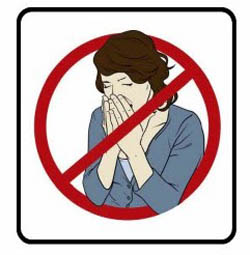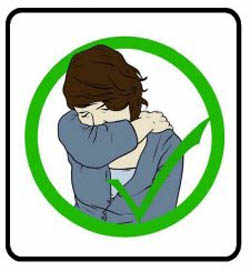 |
Manners, Customs, Clothing
Why Not a Handkerchief?
Judith Fife Mead
I was working on the last phase of a book on courtesy (recently published by TIA) when I received a video of Kathleen Sebelius publicly chastising a reporter at a press conference for sneezing and not using his sleeve to stop it. The Health and Human Services Secretary proceeded to give a demonstration of how one should perform this act, sarcastically suggesting that the reporter receive a class on the topic from Elmo, a puppet on Sesame Street.

Sebelius demonstrating the supposedly correct way to sneeze - into her jacket sleeve |
The performance of Sebelius could not be more demeaning and prosaic. During a press conference, she arrogantly took on the air of a mother disciplining a bad little boy who has sneezed into his hand instead of his sleeve.
“I mean, what is that about? Jeeeez!” she said. Press secretary Robert Gibbs, the good boy in class, stepped into the act, “I want to point out that Margaret sneezed a few minutes ago, very correctly, in the sleeve.” Then Mrs. Sebelius instructed someone to quickly bring the errant reporter a hand sanitizer – as if the germs were somehow mysteriously spreading through the air faster on his hand than they would have on his sleeve. It seemed like a scene from a sitcom – but no, this is real life drama at the Obama White House.
More shocking than Sebelius’ incredible condescension, however, is the whole notion of teaching people to sneeze into their sleeves. It is difficult to believe that after centuries of training people to use handkerchiefs rather than sleeves for wiping their noses and sneezing, now, in 2009, the Health and Human Services Secretary decrees that the latter is the preferred method of hygienic conduct.
Why not use a handkerchief? Have we really become so impulsive a people that we have to react by sneezing into the sleeve instead of using a handkerchief? I cannot understand how so many educated and apparently civil persons are jumping on the sneeze-in-the-sleeve wagon, heralding this practice as something that is very practical, sensible and hygienic. It seems to me it is admitting defeat in the field of civility and handing the banner over to a new barbarianism without a fight.
I thought I would check with some popular etiquette manuals to see how – in saner, more courteous times – we dealt with the problem of sneezing. The 17th edition of the Emily Post book, edited by Peggy Post, gives this advice:
“To lessen the risk of passing on a cold, you should wash your hands several times a day (hand contact passes the virus to anything you touch) and sneeze into a handkerchief or tissue.”
If you are at the dinner table, she elaborates a bit more: “When you feel a sneeze or a cough coming on, cover your mouth and nose with a handkerchief or tissue – or your napkin, if that’s the only thing within reach. (In an emergency, your hand is better than nothing at all. If a coughing or sneezing bout is prolonged, excuse yourself until it passes.)”

School posters demonstrating the supposedly correct - and incorrect - way to sneeze
 |
This makes good sense and maintains the dignity of the person. If a person sneezes into his hand, it is a simple matter to excuse himself to wash his hands, a habit easily learned and acquired. But this practice is not even being presented as an option anymore. Instead, there are posters and signs being printed and posted today that instruct everyone to sneeze into the sleeve. So, the man, woman or child sneezes – and carries the mucous and germs all day on the sleeve of his jacket or shirt. That is revolting, in my opinion.
That has also been the general opinion in polite society for centuries. Medieval courtesy manuals – written by monsignors and courtiers – considered it elementary that ladies and gentlemen do not sneeze or wipe their noses in their sleeves.
The fifth rule in George Washington’s Rules of Civility – carefully handwritten by our first President when he was young and preparing to appear in society – addresses the question of coughing or sneezing. His advice: “Put your handkerchief or hand before your face and turn aside.” To do otherwise was to appear uncouth, a country bumpkin.
Those were the days when all men and boys and, of course, ladies and girls carried handkerchiefs. I, for one, am not prepared to relegate the handkerchief to the dust bin. I am constantly “on a hunt” for beautiful linen hankies. When I find one with elegant lace or hemstitched borders, with embroidered or appliquéd accents, I am especially pleased. Estate sales are great sources for these items, after the contents of the attics and trunks of family members have been exhausted. I then give these treasures as presents to my friends and relatives.
I challenge you to begin a campaign in your own community to “rescue” handkerchiefs from a fate of obsolescence. Your family members and friends will be happy to be the beneficiaries of these lovely antique items. The current flu season provides an excellent opportunity to send handkerchiefs as gifts. You will not only be helping to prevent the spread of germs. You will be doing your part to save a very important part of civilized behavior.

Posted November 11, 2009

Related Topics of Interest
 Style Reflects Moral Profiles of People and Epochs Style Reflects Moral Profiles of People and Epochs
 St. Isidore of Seville on Dignified Manners St. Isidore of Seville on Dignified Manners
 Courtesy in the Catholic Home Courtesy in the Catholic Home
 Cleanliness and Good Hygiene Cleanliness and Good Hygiene
 Dressing Well: Vanity or Virtue? Dressing Well: Vanity or Virtue?
 The Debutante Ball in Laredo The Debutante Ball in Laredo
 Refinement and Sanctity Refinement and Sanctity

Related Works of Interest
|
|
Manners | Cultural | Home | Books | CDs | Search | Contact Us | Donate

© 2002- Tradition in Action, Inc. All Rights Reserved
|
 |

|